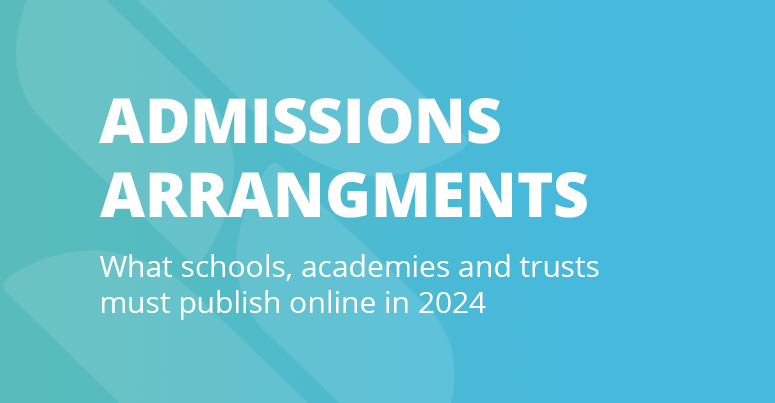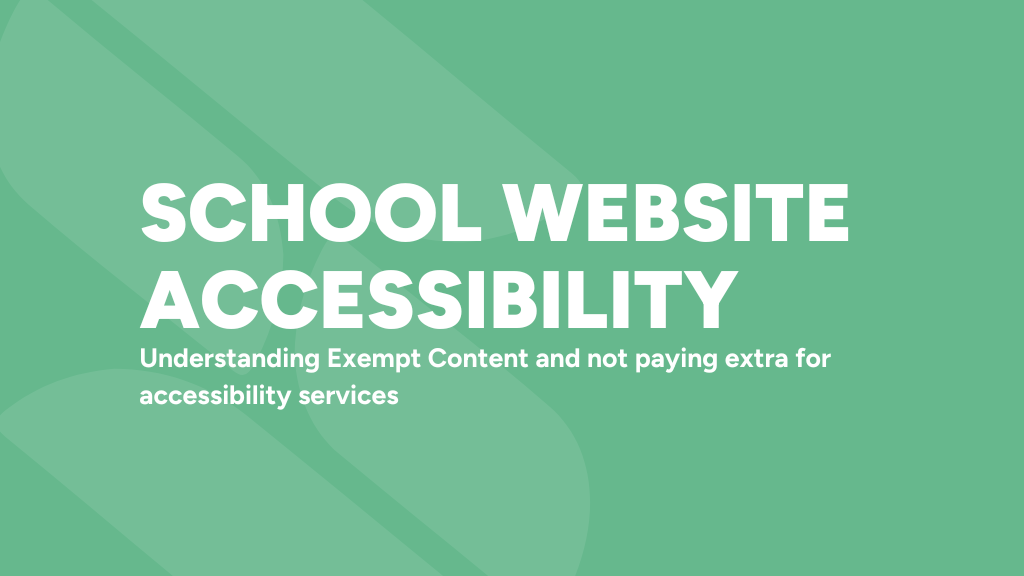School Admissions Code and What to Publish on Your School Website
School Admissions Code and What to Publish on Your School Website
School Admissions Code and What to Publish on Your School Website

Getting your school admissions regulations right on your website is paramount for two key reasons. Firstly, school admissions constitute a significant section of school website requirements. Secondly, admissions information is often the first reason a prospective parent or carer visits your site, seeking details on your admissions procedures.
Therefore, your admissions page must be more than just compliant; it needs to provide a welcoming and informative experience. The regulations can vary based on your school setting. Also, requirements are more complex for schools that determine their own admissions.
Also, always consider your visitors, understand their needs, and aim to provide the best possible experience.
School Admissions Regulations
Admissions serve as the entry point to your school, and prospective parents will almost certainly review them as they navigate your website. Therefore, a clear and detailed admissions page can set an excellent first impression, making it essential to align with the latest school admissions code.
Understanding the School Admissions Code
The school admissions code outlines the regulations all admission authorities must follow. This includes maintained schools with governor-determined admissions, academies, and free schools. The code ensures that all schools adhere to a consistent and fair admissions process. Here, we detail what your school needs to publish online regarding admissions to comply with the latest requirements.
September Admissions – Normal Point of Entry
By 15 March each year, your school or trust must publish the admission arrangements for children starting school on its website at the normal point of entry in September of the following year. These arrangements must remain on the website for the entire academic year in which offers for places are made.
The admission arrangements must clearly explain:
- Application Process: How the trust considers applications for places in each relevant age group.
- Published Admission Number (PAN): The number of children the trust intends to admit in each relevant age group.
- Application Requirements: What parents or carers need to do to apply for their child to attend one of the trust’s schools.
- Allocation of Places: How the trust allocates places if there are more applicants than available spots.
Additionally, where applicable, the school or trust must explain:
- Selection for Selective Schools: How children applying to a selective school are chosen for a place.
- Deferred or Delayed Entry: The process for parents or carers of primary-age children to request that the school delays or defers their child’s entry to reception, including admission outside the normal age group.
- Sixth Form Admissions: The number of external applicants a school intends to admit into the sixth form.
In-Year Admissions
By 31 August each year, the school or trust must publish how it will manage in-year applications for places, which are applications for places in the middle of a school year or to start in a non-normal entry year in September.
If the trust manages these applications, it must provide:
- Application Form: An application form for in-year admissions.
- Supplementary Information: Any necessary supplementary information to support the application.
If the local authority manages these applications, the school or trust must publish a link to the local authority’s in-year application coordination scheme.
Admission Appeals
By 28 February each year, the school or trust must publish a timetable outlining how it will organise and hear admission appeals. This timetable must:
- Appeal Lodging Deadline: Include a deadline allowing parents or carers at least 20 school days from the date of notification that their application was unsuccessful to prepare and lodge a written appeal.
- Submission Deadlines: Reasonable deadlines for parents or carers to submit additional evidence, for admission authorities to submit their evidence, and for the clerk to send appeal papers to the panel and parties.
- Notice of Appeal Hearing: Ensure that parents or carers lodging an appeal receive at least 10 school days’ notice of their appeal hearing.
- Decision Letters: Ensure that decision letters are sent within 5 school days of the hearing, wherever possible.
Further guidance on organising admission appeals can be found in the school admission appeals code.
Requirements for Different School Types
Community and Voluntary-Controlled Schools
For community and voluntary-controlled schools, where the local authority manages the admissions process, it is essential to publish a link to the local authority’s website. Since the local authority handles both processes, so that all necessary information is readily accessible.
Special Academies, Alternative Provision Settings, and Stand-Alone 16 to 19 Institutions
The school admissions and appeals codes do not apply to special academies, alternative provision settings, or stand-alone 16 to 19 institutions. However, these institutions should still publish their admission arrangements by the September of the academic year before applications are made. This allows parents, carers, and young people to make informed choices, with the arrangements remaining unchanged during that year.
The admission arrangements should include details of:
- Open Days: Planned open days for prospective students and their families.
- Application Process: How to apply for a place at the institution.
- Priority Applications: Whether the institution gives priority to applications from pupils enrolled at particular schools.
Competition and Oversubscription
Admissions are becoming increasingly competitive, particularly for schools with an Ofsted rating of ‘good’ or ‘outstanding’. Oversubscription criteria must be clearly published. Detail the process for when more students apply than there are places available. Also, this includes accounting for different groups of students and the criteria used in tie-break situations.
Additionally, any changes to the admissions and oversubscription criteria must be made in advance of the admissions process and include an admissions consultation. The consultation information must be published on the admission authority’s website for the duration of the consultation period. For schools that determine their own admissions, this means the school website.
Key Dates for Admissions and Consultations
Key Dates for School Admissions
To ensure your school remains compliant with the latest school admissions code, it is essential to adhere to the following key dates. These dates help streamline the admissions process and ensure timely publication of necessary information on your school website.
Key Dates Summary:
- Consultations on Admission Arrangements:
- Start Date: 1st October
- End Date: 21st January
- Duration: Consultations must last for a minimum of 6 weeks within this period.
- Admission Appeals Timetable Publication:
- Deadline: 28th February
- Details Required:
- Deadline for lodging appeals (minimum 20 school days from the date of application notification).
- Deadlines for submitting additional evidence.
- Notice periods for appeal hearings (minimum 10 school days).
- Timelines for issuing decision letters (within 5 school days of the hearing, wherever possible).
- Confirmation of Admission Arrangements:
- Deadline: 28th February
- Action: Schools must confirm their admission arrangements for the determination year by this date.
- Publication of Admission Arrangements for Normal Point of Entry:
- Deadline: 15th March
- Action: Schools or trusts must publish the admission arrangements for children starting school in September of the following year.
- Publication of In-Year Admission Arrangements:
- Deadline: 31st August
- Action: Schools or trusts must publish how they will manage in-year applications for places, including application forms and supplementary information, or links to the local authority’s scheme if applicable.
- Publication of 16 to 19 Academies and FE Colleges Admission Arrangements:
- Deadline: By the September of the academic year before applications are made.
- Action: Publish admission arrangements to ensure parents, carers, and young people can make informed choices.
Adhere to these key dates to ensure timely publication of all required information. Furthermore, by following these dates and best practices, your school can maintain compliance with the school admissions code and provide a seamless experience for prospective parents and students.
Latest Updates to School Website Admissions
The Department for Education (DfE) updated its requirements for school admissions regulations recently.
Latest Requirements as of 15 May 2024
To ensure compliance with the latest updates, the following information must be published on your school website:
- Admission Arrangements for Normal Entry: By 15 March each year, detailing the application process, PAN, application requirements, and allocation process.
- In-Year Admissions Management: By 31 August each year, including application forms and supplementary information or links to the local authority’s scheme.
- Admission Appeals Timetable: By 28 February each year, including deadlines for lodging and submitting appeals, notice periods, and decision letter timelines.
Download the School Website Requirements Guide for full details all new requirements.
Special Guidance for Multi Academy Trusts (MATs)
Managing admissions across multiple schools within a Multi Academy Trust (MAT) can be a complex task. However, there are opportunities to streamline and centralise this process using innovative tools. One such tool is Schudio’s ‘Shared Document Groups’ function, which provides MATs with a unique capability to centrally manage all policies and embed them across all their schools’ websites.
Benefits of Centralised Control for MATs
- Consistency Across Schools: By centrally managing admissions policies and procedures, MATs can ensure a consistent approach across all their schools. This uniformity helps maintain compliance with the school admissions code and enhances the trust’s overall efficiency.
- Efficiency and Time-saving: By updating content once and having it reflected across all school websites, MATs can save considerable time and resources. Also, this eliminates the need for repetitive updates on individual school websites and reduces the risk of discrepancies or outdated information.
- Improved Compliance: Centrally managing admissions policies ensures that all MAT schools comply with the latest regulatory requirements. This unified approach simplifies the oversight process for trust leaders, ensuring all statutory content is up to date and easily accessible.
Using Schudio’s ‘Shared Document Groups’ Function
Implement Schudio’s ‘Shared Document Groups’ function. MATs need to manage their admissions content efficiently, and this problem can be solved with the help of the Schudio tool. So, here is how it can be implemented:
- Central Management of Documents: MAT administrators can upload and manage all admissions policies and related documents from a central dashboard. This includes admission arrangements, appeals timetables, and other critical information required by the school admissions code.
- Embed Documents Across Multiple Websites: Once uploaded, these documents can be embedded across all the websites within the trust. This ensures that every school site has the latest and most accurate information without the need for manual updates on each site.
- Automatic Updates: Any updates made to a document within the ‘Shared Document Groups’ are automatically reflected across all embedded instances on the school websites. This feature ensures that all sites are consistently updated in real-time, maintaining compliance and providing accurate information to prospective parents and carers.
- Customisation and Flexibility: Despite the centralised management, each school within the MAT retains the flexibility to customise how the shared documents are displayed on their website. Furthermore, this allows for a personalised touch while maintaining overall consistency in the information presented.
Steps to Implement ‘Shared Document Groups’
- Set Up Central Repository: Establish a central repository for all admissions-related documents within the Schudio platform.
- Upload and Organise Documents: Upload all necessary documents, including admissions policies, appeals timetables, and application forms. Organise them into logical groups for easy management.
- Embed Across School Websites: Use the Schudio platform to embed these documents into the relevant sections of each school’s website within the MAT.
- Monitor and Update: Regularly review the documents to ensure they remain current. Make updates centrally, and let the ‘Shared Document Groups’ function automatically propagate these changes to all school websites.
So, by leveraging the ‘Shared Document Groups’ function, Multi Academy Trusts can achieve a high level of operational efficiency. Furthermore, you can ensure that all your schools are aligned with the latest school admissions code. This enhances compliance and provides a streamlined and consistent experience for parents and carers navigating the admissions process.
So, get in touch with our team to find out more about how we can help your trust.
Conclusion
Staying aware of the requirements and ensuring your school website is compliant with the school admissions code is crucial. This is especially true during times when parents are considering options for their children. Also, your admissions page should not only be a list of documents but also an opportunity to engage with your next group of parents at an early stage.
Finally, keep up to date with your school website requirements with our definitive School Website Requirements Guide. Add this resource to your bank of resources today.








